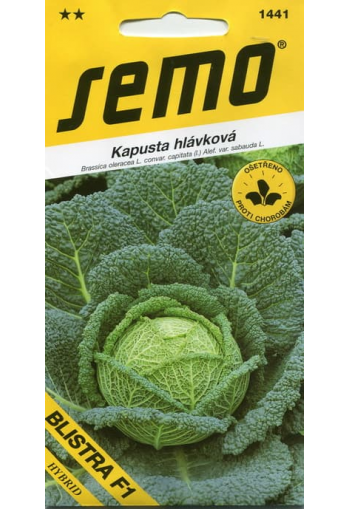Ex Tax: 0.69€
Late-ripening hybrid variety with a vegetation period of 105-110 days, highly resistant to flowering
On the transverse section, the head of the cabbage is yellowish, with a short inner stump. The recommended distance between plants is 60 x 50 cm.
In 1 gram = 250-320 seeds.
Cultivation.
The demands of early and late varieties are very different. Varieties for early field sowing and for cold forcing demand light, warm, sandy-clay soil. The late varieties are suited to medium-heavy soils with sufficient levels of calcium. The earliest sowing into trays can be done from the end of January, direct sowing in March under cover and in April in the field. Late varieties can be sown throughout the whole of May for transplanting or sown directly. The recommended plant spacing for forcing is 30 x 40 cm and for field planting 40 x 40 cm. For mid-late and late varieties the plant spacing is 50 x 50 to 60 x 60 cm.
Seed consumption: 350-500 g /ha.
Harvest: for early varieties, in stages depending on the level of maturity, for hybrids of late varieties it is possible to harvest all at the same time.
Eng.: Savoy Cabbage. Suom.: SAVOIJINKAALI. Sven.: Savoykål. Bot.: Brassica oleracea L. convar. capitata (L.) Alef. var. sabauda L.
* Savoy cabbage is much sweeter than white cabbage, and in its nutritional qualities is in many ways superior to its relative, this type of cabbage is especially useful for children and the elderly.
It, like white cabbage, comes from wild species growing on the shores of the Mediterranean Sea. It got its name from the name of the Italian county of Savoy, whose population has been growing since ancient times. Today, this particular type of cabbage is widespread in Western Europe and the USA, occupying vast areas there. There it is eaten more than all other types of cabbage.
And it's not very common in our country. There are several reasons for this - it is less productive, poorly stored and more demanding to care for.
It tastes like cauliflower in taste. In cooking, Savoy cabbage is considered the best cabbage for making cabbage rolls and pies, it makes the most delicious cabbage soup and vegetarian soups and it is indispensable in summer salads. And any dish from it is an order of magnitude tastier than the same, but made from white cabbage. It is quite obvious that the Europeans and Americans did not make a mistake when choosing the filling for their pies...
In addition to taste, she has another advantage: her leaves are very tender and do not have hard veins, like the leaves of a white relative.
Corrugated leaves of Savoy cabbage are simply intended for cabbage rolls, since it is convenient to place the minced meat in a hollow of a raw leaf, and the leaf itself is easily folded into an envelope or twisted into a tube (it is very plastic without boiling and does not tear).
But it is unsuitable for traditional sauerkraut: it does not have the crunchiness that is so necessary for this dish, like its white "sister"!











